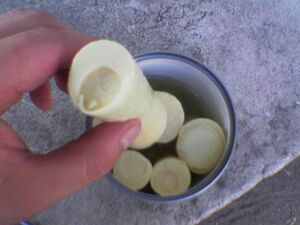Palm hearts

Heart of palm, also called palm heart, palmito, chonta or swamp cabbage, is a vegetable harvested from the inner core and growing bud of certain palm trees (notably the coconut (Cocos nucifera), Palmito Juçara (Euterpe edulis), Açaí palm (Euterpe oleracea), sabal (Sabal spp.) and pejibaye (Bactris gasipaes) palms). It is costly because harvesting in the wild kills the tree. Heart of palm is often eaten in a salad, sometimes called "millionaire's salad," and also in vegetarian spreads.
An alternative to wild heart of palm are palm varieties which have undergone a process of adaptation to become a domesticated farm species. The main variety that has been domesticated is the botanical species Bactris gasipaes, known in Ecuador as “chontaduro,” in Costa Rica as “pejibaye”, and in English as the “peach palm.”
Peach palms are self-suckering and produce multiple stems, up to 40 on one plant, so harvesting several stems from a plant is not so expensive because the plant can live on. Another advantage it has over other palms is that it has been selectively bred to eliminate the vicious thorns of its wild cousins. Since harvesting is still a labor intensive task, palm hearts are regarded as a delicacy.
As of 2008, Costa Rica is the primary source of fresh palm hearts in the US. Peach palm is also cultivated in Hawaii, and now has limited distribution on the mainland, but mostly only to the restaurant trade.
Brazil was the highest producer of uncultivated hearts of palm, but in the 1990s its quality went down - mostly because of unsustainable poaching for stems (called colete, Portuguese for "vest") of the main producing species, Euterpe Edulis - which is now considered as threatened with extinction in the wild. This left the market open for Ecuador to export its cultivated hearts of palm. Ecuador is now one of the main producers of hearts of palm. France is the largest importer of hearts of palm.
Harvesting palm hearts
When harvesting the cultivated young palm, the tree is cut down and the bark is removed leaving layers of white fibres around a center core. During processing the fibres are removed leaving the center core or heart of palm. The center core is attached to a slightly more fibrous cylindrical base with a larger diameter. The entire cylindrical center core and the attached base are edible. The center core is considered more of a delicacy because of its lower fibre content.